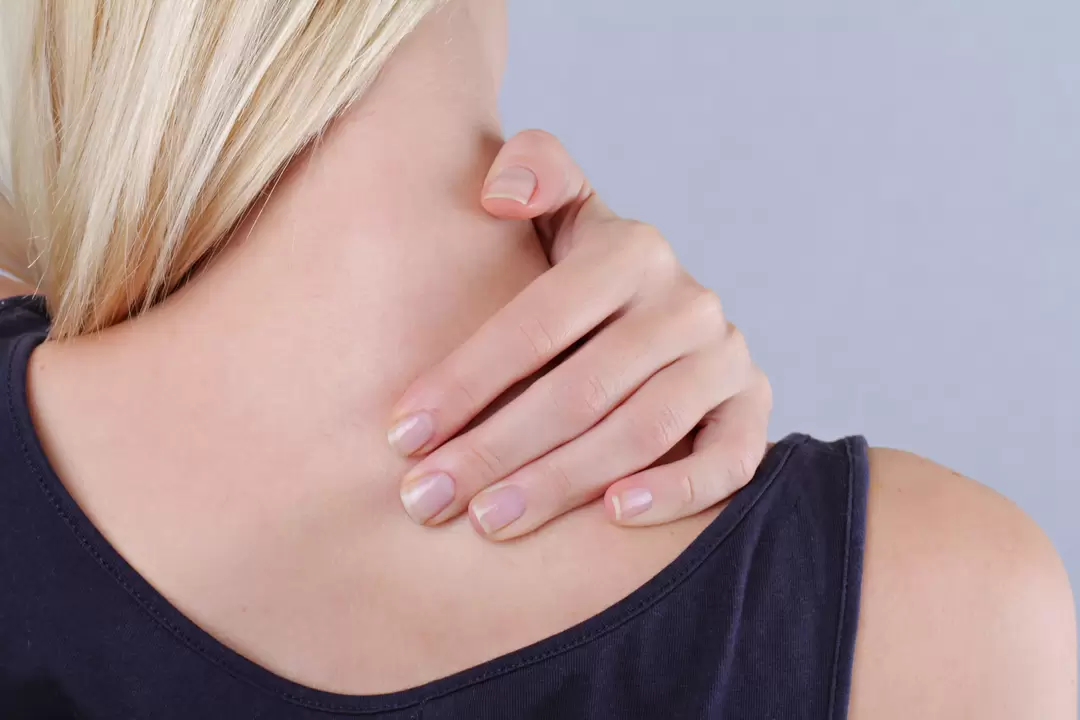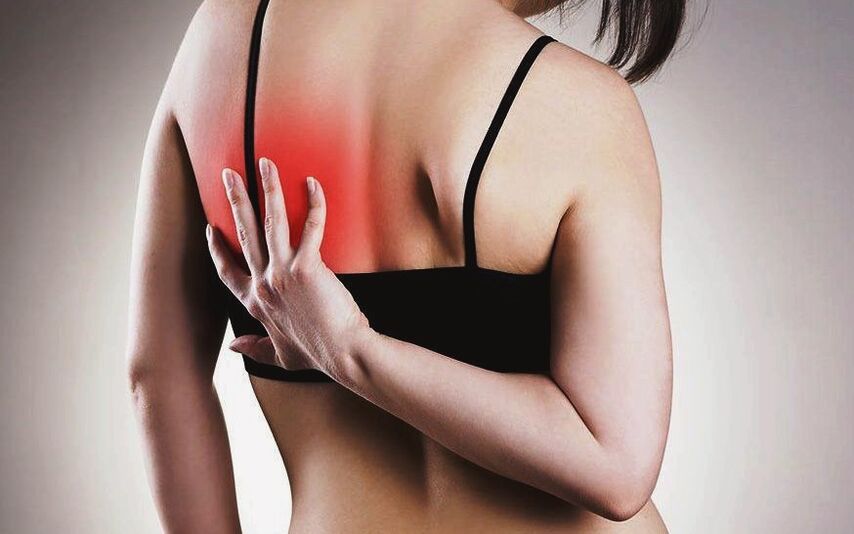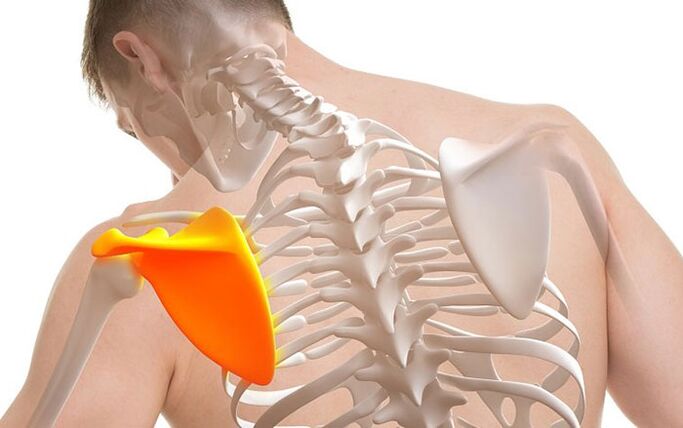
The most common diseases that cause pain under the left shoulder blade behind the back are osteochondrosis, angina pectoris, pneumonia, peptic ulcer and panic attack. Along with the pain syndrome, patients may be disturbed by nausea, vomiting, heartburn, coughing, sputum production, as well as disturbances of sensory and motor functions. Diagnosis of patients' condition is based on research, examination, laboratory and instrumental studies. Treatment tactics depend on the underlying cause of the disease.

Causes
Pain under the left shoulder blade behind the back is a formidable symptom that can be seen in diseases of the spine or serious violations of the functions of internal organs. At the same time, in 7% of cases, this pain syndrome occurs due to a surgical pathology that requires urgent surgical intervention.
Among the main causes of pain in the left shoulder blade region are:
- Spinal diseases (congenital malformations, ankylosing spondylitis, spondylosis, osteochondrosis, intervertebral hernia, etc. ), causing compression of the spinal roots;
- Muscle pathologies (dermatomyositis, fibromyalgia, etc. ), which cause a characteristic pain - myalgia;
- Neurological disorders (Guillain-Barré syndrome, polyneuropathy, intercostal neuralgia, etc. ), which are characterized by the onset of specific neuropathic pain;
- Internal organ diseases:
- Hearts - angina pectoris, arrhythmia, heart attack;
- Lungs - bronchitis, pneumonia, tuberculosis, pleurisy;
- Stomach - gastritis, ulcers, polyps;
- Spleen - ruptures and other pathologies.
- "Blood cancer" (leukemia), due to which pain is noticed in the thickness of the bones that contain the bone marrow (pelvis, sternum, shoulder blades, tubular bones).
Sometimes pain syndrome is caused by disorders of the autonomic nervous system, which regulates the work of all organs and systems. In these cases, we are talking about an exacerbation of vegetovascular dystonia - that is, about a panic attack.
Symptoms
The most common cause of pain under the left shoulder blade is osteochondrosis, angina pectoris, pneumonia, peptic ulcer or panic attack.
osteochondrosis
The disease is caused by destruction of the intervertebral disc, which normally "smooths" movement in the spine. Typically, the pathology occurs against the background of extreme physical exertion and natural aging of the body.
Thus, the destroyed intervertebral disc (often in the cervical region) protrudes and infringes on the spinal roots. For this reason, patients (on the side of the injury) are concerned about sharp pain in the back of the head and neck with spread to the shoulder blade and shoulder area. Over time, superficial sensitivity is disturbed in these areas, due to which patients do not feel temperature and vibration in the skin.
As the disease progresses, the brachial plexus is involved in the pathological process, which makes shoulder mobility very difficult. At the same time, the strength of the muscles of the affected arm is significantly weakened, which in advanced cases leads to immobilization.
angina pectoris
Angina pectoris is a painful syndrome that occurs in the chest, also known as "angina pectoris". The cause of pain is a violation of the blood supply to the heart muscle due to vasoconstriction or the formation of cholesterol plaques in its lumen. Provoke an attack of stress, emotional and physical overload.
Patients are usually concerned about a sudden stabbing or burning pain in the chest area. In this case, the pain usually spreads to the left shoulder blade as well as along the ulnar surface of the left hand to the little finger. Often, the pain syndrome is combined with a feeling of interruption in the heart's work and the fear of death.
Pneumonia
Inflammation of the lungs is a disease, often caused by a bacterial or viral infection. As a rule, patients complain of a significant increase in temperature (up to 39. 5-40 ° C), fever and "stabbing" pain in the chest or shoulder blade of the affected lung. In this case, the pain is aggravated by sneezing, coughing or heavy breathing.
With the development of the disease, coughing and separation of purulent sputum occurs, which sometimes acquires a "rusty" character (due to impurities in the blood). Patients often experience shortness of breath and shortness of breath, even with little physical activity.
stomach ulcer
The cause of the disease is the local destruction of the gastric mucosa with the formation of a peptic ulcer (ie, ulcers). The triggers are a bacterial infection (Helicobacter), hyperacidity and gastric motility disorders.
The main complaint of peptic ulcer is paroxysmal pain in the upper part of the abdomen (epigastrium), which occurs or intensifies after eating. Often, exacerbations of the disease are combined with nausea and vomiting, which brings relief. In the interictal period, patients complain of heartburn, belching, swelling and heaviness after eating.
vegetative crisis
The cause of the pain may be an attack of vegetovascular dystonia, also known as a panic attack. Typically, patients are concerned about "migrating" pain, which occurs in the region of the heart, or under the scapula, or in the abdomen, etc.
At the same time, patients complain of fever, sweating, tremors, shortness of breath, fear of going crazy or confused thoughts.
Such crises can be a manifestation of both organic (adrenal gland tumor, heart disease) and mental (phobias, depression, post-traumatic syndrome) pathology. In some cases, panic attacks are the result of taking medications.

Diagnosis
Diagnostic measures usually consist of:
- A survey that makes it possible to determine the conditions of occurrence and nature of pain;
- Clinical examination with clarification of pain location and identification of pain points;
- Laboratory tests to detect infection (with pneumonia or ulcer), inflammatory changes in blood or muscle protein levels, indicating their destruction (troponin in myocardial infarction);
- Instrumental methods using X-rays, ultrasound, computed tomography or magnetic resonance imaging.
In addition, in case of a heart attack, an electrocardiogram is performed and, in case of a stomach ulcer, fibrogastroduodenoscopy (examination of the stomach with an endoscope).
Treatment
If the pain occurs under the left shoulder blade behind the back, patients should urgently seek medical help because. such a pain syndrome may indicate an emergency (myocardial infarction, ruptured spleen, ulcer perforation, etc. ). In this case, it is not recommended to take painkillers, because. pain relievers can hide symptoms and complicate subsequent diagnosis!
- Osteochondrosis. Basic therapy includes non-steroidal and steroidal anti-inflammatory drugs. Muscle relaxants are used to relieve muscle spasm. As a long-term treatment aimed at delaying the destruction of the intervertebral disc, chondroprotectors are prescribed.
- Angina. Relief from an acute attack is carried out with the help of nitrates. However, general therapy is based on lifestyle changes, use of acetylsalicylic acid (to "thin" the blood), as well as statins to lower cholesterol levels.
- Pneumonia. The main drug in the treatment of pneumonia is an antibiotic, the choice of which depends on the agent causing the infection.
- Stomach ulcer. The treatment of an ulcer consists of destroying the provoking bacterium (Helicobacter pylori). For this purpose, various antibacterial agents are prescribed, as well as drugs that reduce the acidity level of the gastric contents.
- vegetative crisis. In most cases, the treatment of panic attacks can be limited to psychotherapy sessions. At the same time, the appointment of psychotropic substances (antidepressants, tranquilizers) is most often unjustified.
Preventive measures
The prevention of pain under the left shoulder blade behind the back is based on:
- timely diagnosis of congenital and acquired diseases of the spine (fusion of cervical vertebrae, spondylosis, osteochondrosis, intervertebral hernia, injuries);
- early detection of muscle pathology (dermatomyositis, fibromyalgia);
- restoration of neurological disorders (intercostal neuralgia, polyneuropathy);
- treatment of diseases of internal organs:
- heart - angina pectoris, arrhythmia, heart attack;
- lungs - bronchitis, pneumonia, tuberculosis pleurisy;
- stomach - gastritis, ulcers, polyps;
- spleen - ruptures and other pathologies.
- perform a screening blood test for the purpose of pre-symptomatic leukemia diagnosis.
Remember, left shoulder blade pain can indicate acute pathologies that require emergency treatment or surgery!



































